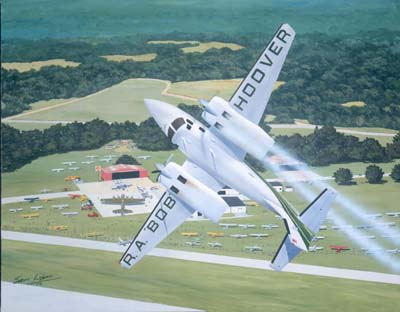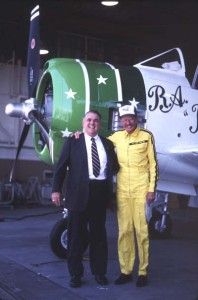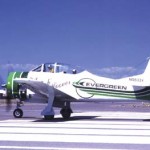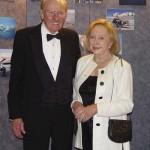Flight Officer Robert Hoover had been a prisoner of war for 15 and a half months when he escaped from Stalag Luft I in April 1945. His escape route led him to an abandoned Luftwaffe base, where he discovered a flyable Focke-Wulf 190, the same type of aircraft that had shot him down after he had flown 58 successful missions for the 20th Fighter Group. He flew the aircraft to safety in Holland.

“Hoover’s Maneuver,” by Sam Lyon, shows Bob Hoover taking his famous Shrike Commander through one of his most impressive hold-your-breath routines. He’s doing a Cuban-8 with one engine shut down and the prop feathered.
After returning to the United States, the Nashville, Tenn., native was granted his wish of being assigned to Wright Field, although he didn’t have the educational background or engineering knowledge necessary. He was enrolled in test pilot school, and had various assignments before the first lieutenant was told he was the most likely candidate to pilot the Bell X-1 to break the sound barrier, after civilian test pilot Chalmers “Slick” Goodlin was removed from the project.
However, his hopes were shattered when Col. Albert Boyd, in command of the Flight Test Division, passed the assignment to his friend and favorite dogfighting opponent Captain Chuck Yeager, after Hoover was disciplined for an irresponsible act he had carried out months earlier.
Although he was no longer in the number one slot on the X-1 program, he remained in the program as Yeager’s backup, and flew chase on Oct. 14, 1947, when Yeager broke the sound barrier. One of the great disappointments in his life was that he never flew the X-1. Before he had a chance to, he suffered serious injuries while testing an F-84 Thunderjet, when its engine caught fire over the Antelope Valley. After ejecting, his body hit the aircraft’s tail.
Although a blow to his head had stunned him temporarily, as he was free falling, he was able to pull the ripcord on his parachute, and landed crumpled up on the ground, due to his injured legs. But wind kept the parachute inflated, and it continued dragging him across the desert. Finally, sagebrush caught the bottom of the parachute and it collapsed. Hoover had been on the ground for at least an hour when a farmer found him, and rushed him to Antelope Valley Hospital, in Lancaster.
Since he was military, they left him on a gurney in the hallway, and called the base to send an ambulance. When a nurse came by, Hoover talked her into giving him something for his pain.
“She gave me a big shot of morphine,” he said. “It didn’t help.”
At the base, his legs were X-rayed, and although he was sure both legs were broken, he was told only his left was. That leg was placed in an ankle-to-hip cast, and his right leg left in a brace.
When Hoover’s right leg continued to bother him, he finally returned to Wright Field for further examination, where it was determined that it was broken. After six weeks of rehabilitation, Hoover resumed his test-pilot duties at Wright Field.
“I could fly again, but the X-1 was behind us at that point,” he said.
Changing course
Hoover left the military behind when he joined General Motor’s Allison Division as a test pilot, in December 1948. The change meant double pay, which meant a little larger nest egg for the 27-year-old Hoover and his wife, the former Colleen Humrickhouse, whom he met on a blind date, and married in September 1947.
In January 1949, at $850 per month, he began his work with General Motors, testing Allison engines at Weir Cook Airport in Indianapolis, Ind. In 1951, he began working for North American Aviation, located at Los Angeles International Airport and headed by James H. “Dutch” Kindelberger and Lee Atwood, his second in command.
“I was with that company for 36 years, testing airplanes and demonstrating all over the world,” Hoover said.
At North American, where he was one of six test pilots assigned to engineering, he would eventually test aircraft including the T-28 Trojan, FJ-2 Fury, AJ-1 Savage, F-86 Sabre and F-100 Super Sabre.
When Atwood reorganized and expanded the company, including forming a marketing department, in 1955, Hoover was appointed director of customer relations and assistant to the marketing director. Soon after that, Atwood appointed Gen. Austin Davis to head the aircraft divisions in Los Angeles; Tulsa, Okla.; and Columbus, Ohio. Austin asked if Hoover could become his executive assistant.
“I had been promoted out of flight test, but Lee said that as long as I wished to fly, no matter what capacity I had in the company, I could do so,” Hoover explained.
That was good, since there didn’t seem to ever be a time when Hoover didn’t want to fly.
The Aero Commander
In the mid-1950s, Hoover began flying civil and military aircraft manufactured by North American at various air shows. A decade later, shortly after the 1968 merger between North American Aviation and Rockwell, he was sent to Oklahoma City to evaluate Rockwell’s Aero Commander division. While touring the manufacturing operations, he found dozens of unsold aircraft.
“Rockwell had acres of them,” he said. “They were building one a month and losing $13 million a year.”
When Dick Robinson, vice president of sales and later president of the division, asked Hoover if he could develop an aerobatic routine that would instill confidence in and gain attention for the airplane, Hoover thought it might be possible to duplicate demonstrations he had previously performed in the P-38.
“The key was to see whether I could perform the P-38 maneuvers within the structural design limits of the Aero Commander,” he said. “The P-38 was a fighter capable of pulling 7.33 g’s, whereas the Shrike Commander, a twin-engine business aircraft, was limited to 4.4 as a utility design.”
The first public demonstration during the annual National Business Aircraft Maintenance Show in Reading, Penn., went very well, and more followed.
“Once those performances demonstrated the Shrike’s capability, production increased from one a month, to two, and then eventually to eight,” Hoover said.
Reno Air Races
During his final years at North American Rockwell, Hoover assisted Frank Jameson in overseeing corporate marketing and various field offices, and later served as director of special projects.
In 1986, he left Rockwell International to join Del Smith’s Evergreen International Aviation Company, as corporate officer and board member.
In the early 1960s, when Bill Stead asked him to help get an air race off the ground, despite being skeptical, Hoover eventually consented. The first Reno Air Races and Air Show was held in 1964. That year, in his P-51 Mustang, Hoover served as the official starter. He would continue the tradition for over three decades.
In 1973, Hoover began flying aerobatic demonstrations in a Shrike Commander 500S (N500RA). About 10 years later, he began flying both the P-51 and the Shrike for demonstrations.
Any description of Hoover’s aerobatic performances usually includes the word “incomparable.” Although he had many spectacular maneuvers, audiences over the years particularly waited for his signature “Dead Engine Energy Management Maneuver.” Performing from 3,500 feet above the ground, Hoover dived the plane to ground level with both engines shut off and propellers feathered. After pulling the nose up into a loop, he completed an eight-point hesitation slow roll. Then, upon recovery, he maneuvered the plane through a 180-degree turn before heading toward the runway. He followed a touchdown on one wheel with a touchdown on the other one.
“The Aero Commander and the Lockheed P-38 Lightning were the only planes I used for that maneuver,” Hoover said.
Hoover said that along with the Sabreliner, another aircraft he performed in often, the Shrike is probably the most challenging of all the airplanes he ever flew in air shows.
“That’s because neither plane was designed for high-stress loads requiring constant attention to flying a sensitive and delicate profile,” he said.
For many years, Hoover performed in his trademark business suit and Panama hat. He said he wore the hat for several reasons, including sensitive skin, hair loss, and later, skin cancer. However, he abandoned the suit in 1984, after a near-catastrophic fire in Columbus, Ohio, and began wearing a Nomex fireproof flying suit.
Contributions and honors
Hoover’s contributions to aviation include two terms as president of the Society of Experimental Test Pilots. The only person to ever serve twice, he made sure his term in 1969 was memorable by arranging to have the Apollo XI crew of Neil Armstrong, Buzz Aldrin and Michael Collins, fresh out of quarantine after their trip to the moon, receive a special award at the annual awards banquet.
He also arranged for longtime friend, reclusive Charles Lindbergh, to be honored. Although Lindbergh had been asked to be an honorary fellow several times, he had aways declined, but Hoover was finally able to talk him into making an appearance at the symposium, which was necessary for the honor.
“When I brought him on stage, the place just went wild,” he recalled.
His second year was 1971. That year, he arranged for record setters Jackie Cochran, Jacquelyn Oriole and Hanna Reitsch to be present.
“They were three of the most famous woman aviators in the world,” he said. “I got another house breakdown where they just wouldn’t stop applauding.”
Over the years, Hoover has been honored by many organizations, including the International Council of Air Shows, which, at their 1995 convention, inducted him as the first member of their Hall of Fame. In 1986, he received the Lindbergh Medal for lifetime achievement, and in 1988, he was enshrined in the National Aviation Hall of Fame.
“Let Bob Fly!”
Hoover said that during more than five decades of flying, he never flew when he didn’t feel he had the capacity to do so or if he felt he might in any way endanger others. That’s because safety was always his main consideration, and he’s always tried to set an example for other pilots through his behavior, he said.
But in 1992, his flying came under scrutiny by the Federal Aviation Administration. The 70-year-old pilot performed his usual acrobatic routine in the Shrike Commander during that year’s Aerospace American Air Show in Oklahoma City. More than two months later, FAA inspectors Clint Boehler and James Kelln, who had observed the show, reported that Hoover’s flying skills had deteriorated.
Based on their report, the FAA required Hoover to take a battery of tests designed to check his mental and physical competence, administered by an FAA-appointed psychiatrist. Although he passed all the tests and the psychiatrist pronounced him fit, in 1993, his privileges were revoked on an “emergency basis,” and he was told he should surrender his medical certificate.
“Some of these doctors who had never even seen me said I had all these things wrong with me, and then I had other doctors clinically observe me, and they all confirming that it was a bunch of bologna,” he said. “I have many dear friends at FAA; like any barrel of apples, there might be a couple of rotten ones here and there. I just happened to run into them.”
Hoover’s good friend and renowned defense attorney F. Lee Bailey volunteered his efforts throughout three years of legal proceedings, backed by his colleague, John Yodice. Shortly before an administrative law hearing was to take place in Oklahoma City, in front of Judge William R. Mullins, Hoover passed several thorough exams performed by Dr. Brent Hisey, a neurosurgeon. As a result, Hisey and a colleague, Dr. David Johnson, agreed to testify for him in court.
Hoover said that although they were successful at that hearing, the National Transportation Safety Board reversed the judge’s decision. What followed were unsuccessful appeals all the way to the U.S. Supreme Court.
On April 13, 1994, the FAA informed Hoover he could no longer fly solo in the U.S. Hoover said the arbitrary action disregarded the fact that he had flown 33 demonstrations since the investigation had begun, without incident. But that decision would stand for 18 months.
Besides restricting him from what he enjoyed doing most, the grounding also hurt him financially, since sponsored air show performances had been his main source of income for several years, to the tune of about a million dollars a year. But Hoover was far from alone throughout his predicament. Besides the emotional support of his wife Colleen, son Rob and daughter Anita, he had the support of the “Friends of Bob Hoover,” a financial-help group formed to aid his legal defense, headed up by Tom Poberezny, Chuck Yeager, Jim Brown and famed aerobatic pilots Leo Loudenslager, Sean Tucker and Steve Oliver.
“This was costing me a lot of money before Lee volunteered to do it for nothing,” he explained.
He also received letters of support from around the world. His supporters included Margeret and Terry Mulholland, friends from Tasmania, Australia, who were planning Sky Race ’94, the first pylon air race there, and who had earlier asked Hoover to start their races, and perform every day in a Shrike and a T-28.
When Dr. Rob Liddell, director of aviation medicine for the Civil Aviation Authority in Australia, suggested Hoover take an Australian First Class medical examination, he did and passed. Liddell also arranged for him to take a commercial pilot’s license written exam and flight check.
“He reviewed all of the data and was absolutely convinced that there was no foundation for any of the allegations,” Hoover said.
Following completion of all of the tests and the flight check, Hoover received a first-class commercial airline pilot rating, qualifying him to fly anywhere in the world—except the U.S.
In May 1995, Liddell set up a meeting with Dr. Jon Jordan, the FAA federal air surgeon. During the meeting, which Dr. Bob Poole, one of Jordan’s associates, also attended, Hoover agreed to submit to further neurological, psychological and physical tests that Dr. Garry Ferris would coordinate.
“He wrote a seven-page letter and sent it to the federal air surgeon,” Hoover said.
Jordan agreed to have the test results reviewed by independent consultants. In the meantime, friends and supporters continued to apply pressure on the FAA, partially through thousands of letters and complaints to officials, and through a touching show of support at EAA AirVenture Oshkosh 1995, held in July. That year, posted everywhere were flyers stating, “Let Bob Fly!”
Wherever FAA Administrator David Hinson went, Hoover supporters asked about the status of the case. Still, several months went by without a decision. Hoover says it was another lawyer friend, retired Northrop and Lockheed test pilot John Myers, who took the last step in helping him get back his medical certificate, by getting documentation he had from both Great Britain and Australia into Hinson’s hands to read.
On Oct. 19, 1995, Hoover was told that his medical was being reinstated.
“After he read the letters, he knew the palace guard had prevented him from ever knowing the truth of the matter,” Hoover said. “I was back on flight status. After three years, he never knew this case was a fraud!”
Hoover’s ordeal resulted in the 2000 passage of the “Hoover Bill,” which essentially gives the holder of an FAA certificate the right to appeal the immediate nature of an emergency revocation to the NTSB. New final rules pertaining to the appeals of emergency revocations went into effect in June 2003.
Back in the air
Although he was back in the air, Hoover had lost valuable time, and he would soon have a further disappointment. All of his life, he had insurance liability coverage of approximately $20 million. But that changed a couple of years ago.
“All the insurance companies banded together and decided a new limit, because we lost a lot of air show airplanes and pilots about two years before,” he said. “They said, ‘We’re going to limit your liability to $2 million.'”
Although his family told him to keep flying, as long as he enjoyed it, he stopped performing.
“I couldn’t afford to risk my estate when they dropped it that far,” he said. “So I accepted advice I was given and donated my airplane to the Smithsonian.”
In April 2000, he flew his famous Shrike to Sun ‘n Fun. Shortly after that, the Smithsonian took receipt of the aircraft, initially loaning it to the International Sport Aviation Museum in Lakeland, Fla., while the Stephen F. Udvar-Hazy Center was being constructed.
“The airplane was just like brand new,” he said. “I had just had it gone over, not knowing this was going to happen. I spent thousands of dollars getting it ready—even took the landing gear off it.”
On Oct. 10, 2003, after a big send-off breakfast in Florida, Hoover flew the aircraft to Washington Dulles International Airport, in preparation of the December 2003 opening of the center. Steve Clegg, a USAir captain, served as Hoover’s copilot on the flight.
“When we got to Dulles, Jack Dailey, the curator, said, ‘Do you realize your airplane is the only one we’ve ever let taxi into this building?'” Hoover recalled. “I taxied right up to the Concorde, where it was going to be on location.”
Presently, Hoover is a spokesman for Eastern Aviation Fuels Inc., the national marketer of Shell branded aviation fuels. He is also involved in a business venture with Capt. Gene Cernan (USN, ret.), commander of the Apollo XVII mission and the last man to walk on the moon. Los Angeles-based Jet Fleet International sells products and services to private and corporate jet owners at discounted prices they secure by aggregating demand through its large membership base and negotiating with vendors on behalf of its members.
As for his lifetime spent in aviation, Hoover said he was glad he picked something he absolutely enjoyed, beginning with his military career.
“I was excited about it every morning,” he said. “I could hardly wait to get up and find out what I would be flying that day.”
- In 1986, Bob Hoover left Rockwell International to join Del Smith’s Evergreen International Aviation Company.Evergreen International Aviation Company.
- Bob and Colleen Hoover, at the Society of Experimental Test Pilots annual symposium and banquet in 2003.
A Calm Voice in the Face of Disaster Part I
A Calm Voice in the Face of Disaster Part II














